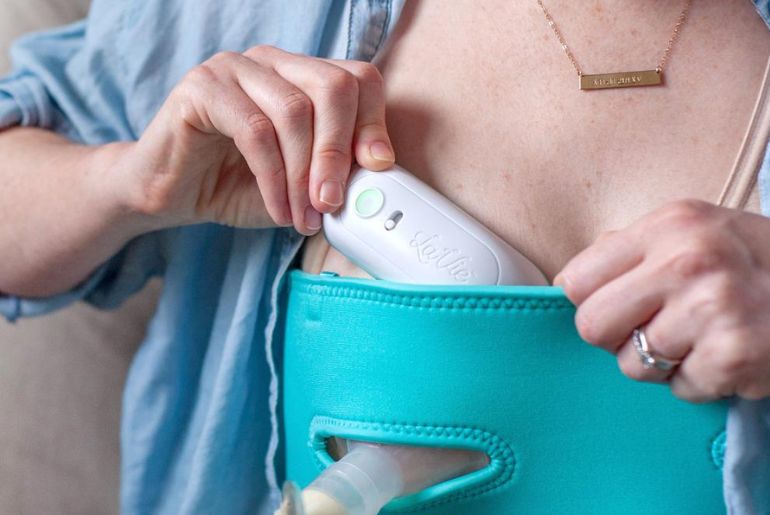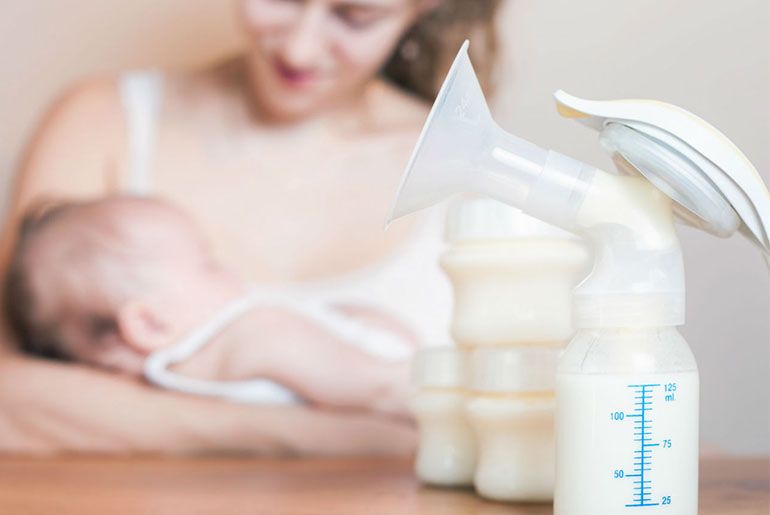Disclaimer: There are affiliate links in this post. At no cost to you, I get commissions for purchases made through these links.
There are many reasons why moms go through purple nipples after pumping. Are you suffering from this condition and wondering how to soothe it?
If you notice a change in the color of your nipples accompanied by pain, something is wrong. It could be in false operations or incorrectly using pumps.
To learn more about each cause and how to fix it, let’s read the article below!
Why Do Your Nipples Turn Purple After Pumping?
Nipples turning purple and sore after a pumping session worry many mothers. This section will delve into the reasons that may create that uncomfortable feeling.
1. Pumping for A Prolonged Time
Pumping too much and for too long is the first cause of nipple discoloration and soreness. The reason is that it restricts the amount of blood to this part. In the long run, this overstimulation will cause supply to outpace demand.
A reasonable time for each pumping session is 15 minutes for each breast. You can pump a little longer if your breasts are still milky, but only for up to 5 minutes.
2. Incorrect Breast Pump Placement
The second reason the nipples turn purple is because of the wrong position of the breast pump. Improper placement can cause bruising, burning, or a serious teat injury.
The correct flange position relative to this part is in the center, not to the right or the left.
3. Wrong Flange Size
Most breastfeeding moms don’t realize that the flanges that come with breast pumps often come in various sizes. This horn-shaped breast shield will rest on the areola during pumping.
When you purchase the pump, you will receive an additional medium-sized flange. It may not fit all busts and sizes. Flanges that are too large or too small can cause your nipples to ache. Worse, it interferes with your milk elimination.
You can check the fit of the flanges before you start pumping. When the size is too small, your teat and areola will be pressed to the device’s surface and move with difficulty. Conversely, a large flange will force the nipple skin inward and cause skin injury.
Using a tight-fitting flange gives your areola the freedom to move. However, it will not cause pain. The trick is that nipples sometimes require different flange sizes. So, you should check and try first before buying.
In addition to ensuring the right size, you can use a little more oil to help the nipple slide inside more easily and reduce friction. Olive oil or coconut oil is a safe and healthy choice.

4. High Suction At High Speed
In fact, pumping milk at full speed and holding it for a long time does not provide much benefit to breastfeeding moms. It will even limit breast milk supply and make areola sore.
The best way to adjust the speed is to gently start the speed and suction level and gradually increase the intensity. Useful advice is that you should not rush when pumping. Be prepared with bottles of milk in advance for unexpected rush situations.
For the milk to flow more easily, you should find a comfortable space and recreate the scene of your baby suckling.
5. Vasospasm
Vasospasm is also known as mammary constriction syndrome. Here, the blood vessels in the teat narrow suddenly. These contractions usually occur when experiencing a sudden cold. It blocks blood flow to the areola and causes pain.
A similar phenomenon that occurs with frostbitten fingers is called Raynaud’s Phenomenon. One obvious sign is the nipple turning white. After the blood gradually circulates, it will have a color change from white, blue, to red.
Compared to nipple blanching, vasospasm usually lasts longer. You can easily feel when your baby stops sucking and pulls the nipple out to expose it to the cool air that causes contractions.
This pain can range from mild to severe. Many women, when describing pain, often confuse it with thrush.
6. Engorgement
Another possible reason your nipples turn purple when pumping is maybe Engorgement. This condition simply explains that the breasts are excessively engorged, causing pain. When you touch it, you will feel this part is warmer and harder than usual.
There are several reasons for this condition. First, the body will overproduce milk after giving birth. Second, it takes more work to empty more often.
Fortunately, you can use a warm or cold compress to ease the pain. A massage or a hot bath can also help you feel better. You can also use backpressure softening to make lactation easier. Take the tip of your finger around the nipple and gently press it.
If you want a more visual look at how to do this, check out the video below.
Another option for you if you don’t want to do the massage yourself is to use a portable device like the LaVie 2-in-1 Warming Lactation Massager. It helps to make pumping hands-free and comfortable, increase milk production, prevent blockages, and speed up pumping time. The warming massage helps to soothe and distracts from the suction sensation on your nipples. It is a great tool for any nursing mother.

7. Mastitis and Plugged Ducts
For mothers dealing with a breast infection (mastitis) or clogged milk ducts, the pain will often come.
In the case of clogged milk ducts, you need to clear the blockage as soon as possible. Actively remove milk using a breast pump or breastfeeding.
A breast massage with a little massage oil is also a reasonable option. You can also solve this problem by applying a warm compress to the nipples.
8. Thrush
If the pump causes nipple skin irritation and damage after use, you may have thrush. It is also known as a yeast infection.
Recognizing symptoms include:
- Flaky and shiny nipples.
- Burning sensation and discomfort.
- Red skin color, rough and cracked texture.
You need to take medicine, such as probiotics, to treat a yeast infection. Don’t hesitate to contact your doctor for the best advice.
How To Make Breast Pumping Less Painful?
If you have resized the flanges and used the breast pump correctly but still have no relief, your nipple and areola have been damaged. Follow some of the methods below to defuse the problem.
1. Soothing Your Skin
If pumping is causing your nipples to swell or become purple, try some of these remedies:
- Apply a soothing lotion to the damaged area. Olive oil is the best liquid for pain relief. Suppose you don’t like the smell of olive oil. In that case, I highly recommend using the Nipple Butter cream to help make your pumping sessions more comfortable, as it not only provides lubrication but also helps to put moisture back into the skin. Plus, all of its ingredients are USDA Certified Organic and made with herbs and oils. You only need to use a very small amount on your fingertips each time.
- Dissolve the water and salt and soak your nipples in the mixture for a few minutes and several times per day.
- After pumping, apply breast milk to the nipples to soothe the skin. Breast milk has anti-infective, anti-inflammatory properties that positively affect areola.
2. Keeping Warm
Episodes of vasospasm usually occur when wet nipples are exposed to cool air. Therefore, you should not air-dry areola, especially in cold weather. Instead, cover this part with a warm towel to block any cold wind from entering.
You should also wear a wool bra or an extra layer of clothing to keep warm. It is also good to sit in a heated chair or keep your hands warm with a heating pad that activates while nursing.
3. Taking Supplements
A mother’s daily diet and food consumption also greatly affect her breasts.
The first thing you need to keep in mind is to stay away from nicotine, caffeine, and estrogen-containing birth control pills. You should stay away from this drug during breastfeeding as it will limit the supply.
Also, take a calcium-magnesium supplement and a 100mg dose of vitamin B6 twice daily. Use them until you no longer feel the pain.

FAQs
There are still a lot of questions surrounding sore and purple nipples when you pump breast milk. If you still have questions, find the answers here.
How Long Will My Nipples Be Sore From Pumping?
When the collagen fibers in your nipples stretch during pumping, it creates soreness. This pain may last for the first 10 to 15 seconds.
Fortunately, this situation won’t last too long. You should only endure the discomfort for no more than two minutes or more if you finish pumping.
Should You Pump With Sore Nipples?
Many mothers worry a lot when their nipples ache while nursing or pumping. Don’t worry because it’s not a big deal. Using a breast pump doesn’t put too much pressure on the nipple so it can rest. Meanwhile, you’re providing enough nutritious breast milk to nourish your baby.
Breast milk also can heal the pain in the breast. Continuous pumping encourages the body to produce new milk sources with germ-fighting ingredients. Although you can endure the pain during a pumping session, that feeling won’t last long. With time and support, the mother will gradually get used to it.
When Should You Be Concerned About Nipple Pain?
Nipple pain is a common pain, and it should not be a serious health problem.
If you experience breast pain with the coming and going of your menstrual cycle, it’s a hormonal change. Conversely, there are many causes of non-cyclical pain.
Talk to your doctor if you have any concerns about this pain, especially when there is a lump in the painful area.
Severe nipple pain will last for more than two minutes for nursing mothers. It takes a heavy toll on your daily personal life and activities in the long run.
To pinpoint the exact cause of the problem, your doctor may recommend imaging tests. It will aid in future treatment.
Will Not Pumping For A Day Affect Your Milk Supply?
Your body produces breast milk on a supply-and-demand basis. However, it won’t be a big deal if you don’t pump once in a while. Of course, this interruption will cause your breasts to feel tight and painful. The engorged breasts then send signals to the brain to produce less milk.
If you repeatedly skip breastfeeding, it can lead to a serious decrease in milk supply. In addition, this action also clogs milk ducts and causes mastitis in the long run. Therefore, always control your schedule reasonably. It is the best way to always feel healthy and full of milk.
Conclusion
To avoid having purple nipples after pumping, you need to do this process correctly. The wrong flange size, improper pump placement, or overusing pumping speed can cause breasts to discolor and ache.
If you have tried to overcome all of the above problems but still suffer from pain, contact your doctor for more specific advice.
Hopefully, this article will make the breastfeeding process more comfortable. Thank you for your interest in the article!



